SABA works in three main areas — advocacy, community engagement and technical assistance — to help create the conditions that enable more people to confidently choose a bike as safe, convenient everyday transportation. Here are highlights from our work this year:
Advocacy
Sacramento Bicycle Master Plan update

What we did: We participated on a technical advisory committee that provided input on goals and priorities for this minor update of Sacramento’s master plan.
Why it matters: A robust citywide plan is the key to realizing all the benefits of increased bicycle ridership, including cleaner air, less traffic congestion, safer streets, more robust retail activity in bike-friendly neighborhoods, and better access to opportunity.
Although this was not the major update Sacramento needs and deserves, the update includes important new features, including an analysis of neighborhood investments, to highlight the need for greater equity; guidelines for matching the appropriate bike infrastructure to each type of street; and stated goals for increasing ridership, improving safety, creating continuous connected bikeway networks, and ensuring that bike infrastructure investments are made equitably throughout the city.
What’s next in 2017: For budget reasons, the updated plan does not contain implementation measures. We’ll continue working with the City of Sacramento to find resources to implement the plan as well as begin conceptual planning on a major update within the next 4-5 years.
Vision Zero
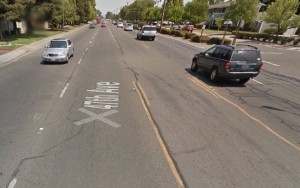
What we did: We’re part of a community task force convened to advise the City of Sacramento Public Works Department on its action plan for implementing a Vision Zero program to eliminate serious and fatal traffic collisions.
Why it matters: A thoughtful, data-driven action plan will direct resources toward safety improvements and other strategies for safeguarding people on bikes. Sacramento has 5 times the rate of bicyclist fatalities as comparable cities with better bike infrastructure. Nearly all of those fatal collisions occur on major arterial streets like 47th Ave., due to the combination of heavy traffic, fast vehicle speeds and inadequate accommodation for bikes (e.g., poor bike lanes or no bike lanes).
What’s next in 2017: By next summer the City of Sacramento will begin community outreach to review a draft action plan. We plan to be an active partner in ensuring that neighborhood-level concerns are reflected in the plan.
Building Healthy Communities initiative
What we did: We continued to receive grant funding from The California Endowment to help improve health, safety and economic opportunity in the Building Health Communities area of South Sacramento. Among several projects, we partnered with WALKSacramento, another BHC grantee, to assess conditions for biking and walking along several major streets in South Sacramento.
Why is matters: The 10-year BHC initiative is intended to address fundamental health, safety and economic needs in the BHC area, while helping build the long-term capacity of neighborhood-focused organizations. We know that residents in lower-income neighborhoods are likelier to use a bike as everyday transportation, yet the BHC area has fewer bike routes and bike lanes, and significant physical obstacles such as large arterial streets and freeway overcrossings that make it more challenging to ride a bike.
What’s next in 2017: We plan to increase community engagement activities by recruiting and employing BHC-based bike mechanics and bike safety instructors to deliver free bike repairs and safety skills training to BHC residents.
Railyards bikeway network
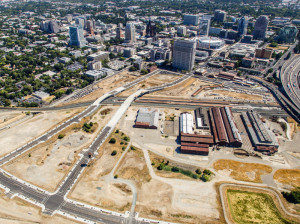
What we did: We reviewed plans and actively advised the Railyards development team on street improvements to make bicycling convenient, safe and comfortable within, to and from the Railyards. One of our main advocacy activities is to review development projects and provide recommendations and comments to improve conditions for bicycling.
Why it matters: The Railyards Specific Plan will govern development in the Railyards for the next 20-30 years, and most of the smaller streets haven’t yet been built. We worked to ensure that the plan provided for bike access from the beginning, especially to identify low-stress, family-friendly bike routes between the Sacramento River and the Sacramento Republic FC stadium site and between the historic Central Shops and the regional park planned for the north side of the development.
What’s next in 2017: With the amended Railyards Specific Plan now approved by the City of Sacramento, we’ll work with major Railyards property owners, including Kaiser Permanente and the Sacramento Republic FC, to ensure that their development projects align with the Specific Plan’s objectives.
Sidewalk riding ordinance
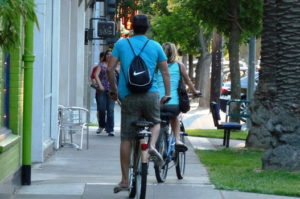
What we did: We helped ensure that proposed amendments to the Sacramento city ordinance regulating bicycles on sidewalks did not limit access for people traveling by bike in neighborhoods with unsafe streets.
Why it matters: Bicycling on sidewalks is unsafe and unfair to pedestrians. It mainly happens on streets that can’t be safely or conveniently used by bike. But enacting laws that punish sidewalk riding without making the streets safer forces people on bikes to choose between what’s legal and what’s safe — that’s unfair too.
Throughout the two-year-long public debate about amendments to Sacramento’s ordinance, we made sure City staff, elected officials, residents and the media understood why investing in bike lanes and other infrastructure improvements is the most effective way to encourage safe bicycling and protect pedestrians. To read about the rules for sharing the road, including rules about sidewalk riding, go here.
What’s next in 2017: We’ll monitor the City’s progress as it continues to implement the amended ordinance. Watch for the City to identify the first streets where sidewalk riding will be prohibited, most likely in the downtown Grid.
American River Parkway off-pavement bicycling pilot program

What we did: We actively participated in and advocated for implementation of Sacramento County’s plan to allow bicycling on unpaved service roads in the Woodlake and Cal Expo areas of the American River Parkway, as authorized under the American River Parkway Plan.
Why it matters: The 3-year pilot program will enable more people to enjoy the American River Parkway by bike, increasing legitimate uses in a part of the parkway where recreational and transportation bicycling is heavily impacted by illegal camping, trash and wildfires. Sacramento County Parks receives $1M a year in Measure A sales tax revenues to maintain the Jedediah Smith biking and walking path, yet the unsafe conditions along the first 6 miles of path from Discovery Park means this annual investment isn’t producing all the benefits it could. Increased activity through off-pavement bicycling will make the Jedediah Smith path feel safer and more accessible.
What’s next in 2017: We’ll continue to participate as a stakeholder as Sacramento County Park launches the pilot program. We expect off-pavement trails to be open by the summer.
Rancho Cordova cycle track project
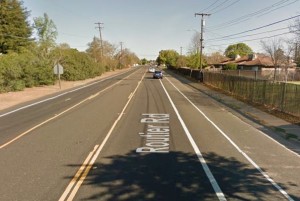
What we did: We provided public and behind-the-scenes support for the City of Rancho Cordova’s plan to install two miles of cycle tracks (AKA separated bikeways or protected bike lanes) along Routier Road and Rod Beaudry Drive between Old Placerville Road and the American River Parkway.
Why it matters: This project is likely to be the first cycle track project completed in our region outside of Davis. Similar projects in other communities have significantly increased bicycle ridership and improved bicyclist safety. We see this project as a model for the rest of the region.
What’s next in 2017: The City of Rancho Cordova has received federal funding to plan and engineer the project. We’ll remain involved as a community stakeholder to ensure that the project meets its objectives.
Community engagement
Bike Valet
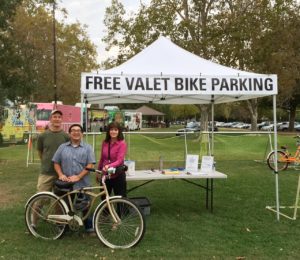
What we did: We parked some 15,000 bikes at nearly 300 individual community events that took place from Davis to Ione and North Natomas to Elk Grove.
Why it matters: Bike Valet turns community events into bikeable destinations. We provide people on bikes with reliable parking where otherwise none might be available, while event organizers who hire us recognize the value of supporting their customers and clients who travel by bike.
What’s next in 2017: We’ll use Bike Valet events to raise SABA’s profile and help generate public support for our advocacy priorities.
Bike Doc
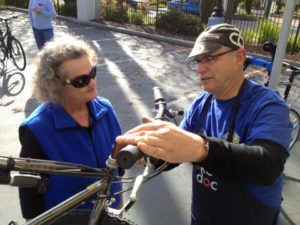
What we did: Through a contract with the North Natomas Transportation Management Association, we employed the bike mechanics who performed free diagnostics and simple repairs on 687 bikes at 23 Bike Doc events organized at schools, parks and residential complexes.
Why it matters: The 100,000 residents of the Natomas area (South and North) are served by just one bike shop. Without ready access to basic repairs, people can’t ride safely or can’t ride at all.
What’s next in 2017: We’ll expand our bike mechanic services to other parts of the region that also have little or no access to bike shop services.
Townie Rides
What we did: We partnered with City Bicycle Works to host regular social rides to Bike Dog Brewing in West Sacramento and other local craft breweries.
Why it matters: Social rides build community among people who want to explore the community with likeminded others. These rides offer a friendly introduction to SABA, for those who don’t already know us. And we love having the opportunity to partner with and promote local small businesses.
What’s next in 2017: More Townie Rides each month! We’ll also look for opportunities to organize other kinds of social rides around different themes.
Technical assistance
Power Inn Alliance active transportation study
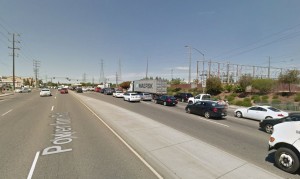
What we did: We’re contracting with the Power Inn Alliance to partner with WALKSacramento to assess needs and opportunities for travel by bicycling, walking and public transit within the Power Inn Alliance boundaries, mainly between US 50 and Florin Road.
What it matters: Employers in this primarily industrial neighborhood employ many low-wage workers who must travel by bike, walking or public transit. However, heavy truck and rail traffic and large busy streets like Power Inn, Franklin, Florin and Florin-Perkins create obstacles to safe travel, limiting employment and economic development opportunities.
What’s next in 2017: We’ll evaluate existing plans, survey employers, workers and residents, and assess the physical environment to identify and prioritize needs and opportunities that Power Inn Alliance can champion with public agencies. This nonprofit-private-public partnership could be a model for similar projects elsewhere in the region.
Assemble Sacramento
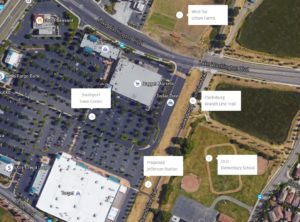
What we did: We receive donations and handle bookkeeping on behalf of this project to develop a privately funded, publicly constructed rest area along the Clarksburg Branch Line Trail in West Sacramento.
Why it matters: Our role in the project is limited, however, we see this kind of nonprofit-private-public partnership as an innovative way to make infrastructure improvements in our region, including future Assemble Sacramento projects.
What’s next in 2017: We’ll continue to serve on Assemble Sacramento’s steering committee, manage the accounting, and help promote efforts to raises funds for the proposed trail improvement.
